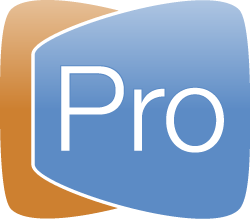Working with Slides
Every presentation in ProPresenter consists of at least one slide, even if it’s just a single media cue. Each slide can tell you a lot about what is going to happen when you click on the slide, including the type of media cue, whether there are any other Cues (actions) that will happen if you click on the Slide, if it is a part of a Group or has a Label, etc.
Slides can be viewed in either the Grid or List View. To toggle these two views, click the view buttons in the lower right corner of the slide view area. Immediately to the right of these buttons is the slide scale slider. You can drag this slider to the left or right to change the size of the slide thumbnails.

Grid View is the default view for ProPresenter. As you can see in the image below, there are a number of visual clues on each slide to help you know what will be triggered on each slide. The first slide includes a Stage Display layout cue. Clicking this slide will change the layout being used for Stage Display. The next two slides have the same video attached, but the first instance is a Background and the second a Foreground. The icon in the upper left corner on each slide matches the icons used in the Video/Image Bin to identify Backgrounds or Foregrounds. Videos are indicated by the timecode in the bottom left corner. The second slide also has a custom transition for the slide that will be used when that slide is clicked, as shown in the bottom right corner. The active slide is outlined in orange.

List View is similar to Grid View, but you also get a plain text view of the slide text in addition to the thumbnail. This view uses the same icons to indicate Slide Cues, media types, and transitions. This view also includes any Slide Notes that you have added to your presentation. The active slide is orange, and more obvious than in the Icon View.

There is also a new Slides by Group option in ProPresenter 6. This option is available at the bottom of the slide view area and works with Grid or List View, although it works best with Icon View.
Rather than all of your slides being mixed together, they are broken down into their individual groups and shown with more separation. If you are using an Arrangement, each instance of a group in the Arrangement will be separated. This view can be helpful if you don’t have a pre-set order for the song and want to be able to quickly find each section of the song.



